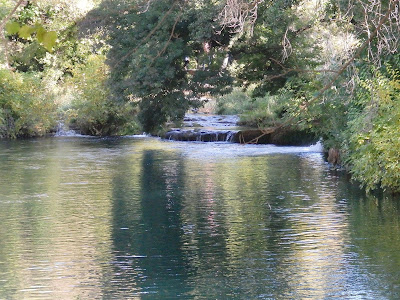 |
| I started the day riding in a bus for over an hour so I saw some of the Croatia countryside. There weren't a lot of people in the rural areas. |
 |
| The Krka River which creates the beautiful landscape to which we were headed. |
 |
| Finally we arrived at Krka National Park. |
 |
| But we weren't to our destination yet. First we descended hundreds of feet to water level. |
 |
| Down a very curvy road. |
 |
| Double click to enlarge for reading. |
 |
| The cascades are composed of travertine barriers, islands, and lakes. They can be viewed throughout the entire year thanks to a network of paths and bridges. |

 |
| Grain hauling wagon |
 |
| Since we were at the park in the fall, the water level was really low. |
 |
| All dry here. |
 |
| This sun lit spot in the clear water contained some fish |
 |
| Travertine ledge missing its water. |
 |
| Click to enlarge |
 |
| Little purple flowers everywhere. |
 |
| About 1/2 way into our walk we came across a picnic area. Displays explaining the various animal and plant life of the area surrounded it. |
 |
| The trail became less level boardwalk and more stairs. |
 |
| Finally we made it to the foot of the falls. |
 |
| This overhead view gives you a better idea of the area we were in. |
 |
| This view from the bridge shows just how shallow the water is in places. |
 |
| Yep, only an inch deep here. |
 |
| After the bridge we started climbing up the hillside. This is a part from the Krka Hydroelectric plant. |
 |
| The Krka Hydroelectric Plant, the world's first hydropower plant to power a city - Šibenik |
 |
| After the park, we headed off to Skradin. |
 |
| Passing over the river again. |
 |
| The restaurant in Skradin where we ate. There were three busloads of people eating all at once. No choice on the food. You ate what they put in front of you. |
 |
| View of the tollbooths to enter the road we were on. |
 |
| Tucked into the side of this canyon is the remains of the Utvrda Kličevica fortress. Just the walls remain. |












































